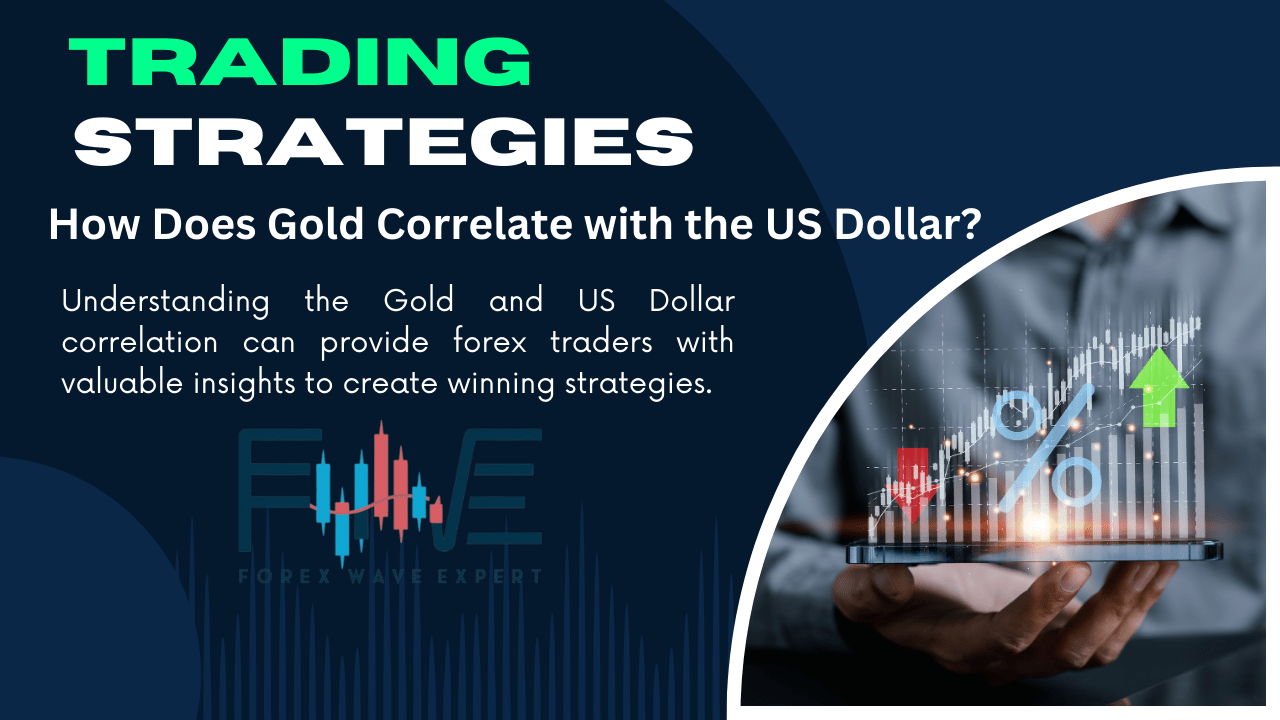How Does Gold Correlate with the US Dollar?
Gold and the US dollar have long been two of the most crucial assets for investors and traders. As a globally recognized store of value, gold has maintained its status as a safe-haven asset for centuries. The US dollar, on the other hand, is the world’s leading reserve currency, underpinning many global transactions. But what is the connection between these two assets, and how can traders use this information to enhance their forex trading strategies?
I, Rana Das, CEO of Forex Wave Expert, will walk you through the dynamic Gold and US Dollar correlation and provide insights on how to use it to your advantage.
The Inverse Relationship Between Gold and the US Dollar
Most of the time, the price of gold and the strength of the US dollar move in opposite directions. This is known as an inverse correlation, and it occurs because gold is priced in US dollars. When the US dollar strengthens, fewer dollars are needed to buy an ounce of gold, leading to a decline in the price of gold. Conversely, when the US dollar weakens, more dollars are required to purchase gold, which drives its price higher.
For instance, when US dollar strength is driven by rising interest rates or strong economic data, investors tend to prefer dollar-denominated assets like bonds. This reduces the demand for gold, causing its price to drop. In contrast, when the dollar weakens due to lower interest rates or economic uncertainty, traders often flock to gold, pushing its price upward.
Gold as a Safe Haven
During times of financial uncertainty, geopolitical tension, or economic turmoil, both the US dollar and gold are seen as safe-haven assets. While the Gold and US Dollar correlation is typically inverse, there are exceptions during crises. For example, in the 2008 financial crisis and the more recent COVID-19 pandemic, both the US dollar and gold saw increases in demand. Investors viewed both assets as reliable stores of value amidst the chaos.
This dual rise happens because traders turn to the stability of gold to protect against market volatility and use the US dollar as a hedge against currency risk. As such, in moments of extreme uncertainty, gold and the US dollar can move in the same direction.
Impact of Interest Rates and Inflation on Gold and the Dollar
The interest rates and gold prices connection is critical for traders to understand. When the Federal Reserve raises interest rates, the US dollar strength typically increases as higher rates attract investors looking for better returns. This leads to lower gold prices since gold does not provide interest or dividends. On the other hand, when interest rates are low or falling, gold becomes more attractive, pushing its price higher.
Additionally, inflation hedge strategies play a crucial role in the relationship between gold and the US dollar. Gold is often considered a hedge against inflation because it holds its value over time, while the purchasing power of fiat currencies, including the US dollar, declines. During periods of rising inflation, gold prices tend to increase as investors seek protection from eroding currency values.

Geopolitical Uncertainty and Gold
Another factor influencing gold prices and their correlation with the US dollar is geopolitical uncertainty. Events like wars, political instability, or trade disputes can trigger heightened demand for gold, as investors look to safeguard their assets during turbulent times. These geopolitical events often cause the US dollar to strengthen, as it remains a trusted global currency.
However, the same events that bolster the US dollar can also drive up gold prices, breaking the usual inverse relationship. Traders need to keep an eye on global headlines and understand how uncertainty in one region can affect both gold and the dollar simultaneously.
Forex Trading Strategies for Gold and the US Dollar
Understanding the Gold and US Dollar correlation can provide forex traders with valuable insights to create winning strategies. For instance, in periods of rising US interest rates, traders might focus on short-selling gold while going long on the dollar. Conversely, during times of economic uncertainty or falling interest rates, traders could do the opposite—buying gold and shorting the US dollar.
One effective strategy is to use gold as a hedge against fluctuations in the US dollar. When traders expect a weaker US dollar, they can invest in gold to offset potential losses from dollar-denominated assets.
By staying informed about interest rates, inflation trends, and geopolitical events, traders can make more informed decisions on how to manage their positions in both gold and the US dollar.
Conclusion
The Gold and US Dollar correlation offers many opportunities for traders to profit. While the general rule is that gold and the US dollar move inversely, exceptions occur during periods of financial crisis or geopolitical uncertainty, when both assets rise together. Factors such as interest rates and gold prices, inflation, and global instability all play a role in shaping this unique relationship.
By understanding these dynamics and incorporating them into your forex trading strategies, you can gain an edge in the market. As Rana Das, CEO of Forex Wave Expert, I encourage traders to stay vigilant, monitor key economic indicators, and adapt their strategies based on the ever-evolving correlation between gold and the US dollar.


Add a Comment
You must be logged in to post a comment